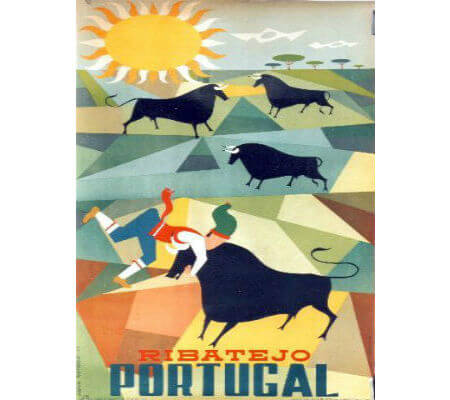Text João Barbosa | Translation Jani Dunne
During the Estado Novo [“New State”] dictatorship (1926 – 1974), several archetypes were created for identifying provinces, the organisational body that no longer exists. There was a reductive nationalist iconography, but also a regional one. People valued folklore highly, and by folklore, I mean fandango [a duel-dance between two men, different from the Spanish fandango].

Ribatejo

Ribatejo
On the Ribatejo archetype they drew wild bulls – the noble animals of the presently polemic bullfights –, campinos [equestrian cattle shepherds] and obviously bunches of grapes. Wine had crucial weight on Economy and the food industry, since this was the only province to mass-produce.
The desire for big production made it so that vines (generalising) were on rich grounds. However, the vineyard is masochistic. Their reputation wasn’t the best until a few years ago. However, the certifying commission and several producers – in a growing number – started changing their image. The corollary move was changing the designation from Ribatejo to Tejo.

Quinta da Lagoalva – Photo Provided by Quinta da Lagoalva | All Rights Reserved
One of the first agricultural organisations to wake up to this new reality was Quinta da Lagoalva de Cima, right by Alpiarça. This company produces a lot more than wine, with olive oil being a high-quality identifying product. A huge amount of produce is farmed there. A lot of produce and forestry can fit into 6200 acres.
There are four degrees of wines at different prices. They share a common trait and then separate into two branches: quality and “honesty”. This truth translates into regularity and consistency in production and sales – however, you must take into account the specific climatic situation of every year.
I refuse to cave into the obsessive urge to sentence (almost decree) the quality/price ratio. To each their own concept and taste, financial availability, and opinion on where prices stop being reasonable. I avoid mentioning prices because I have no data to back any amount. I will only say that these wines are at the reach of a middle-class pocket; they won’t cost you a month’s wage or even a week’s work.
One of the first references I had was the white Lagoalva Talhão 1. I didn’t like it! However, it came closer (I got closer) and it’s a wine (abstract reference) that I enjoy in the Summer as an aperitif or for a relaxed social do. There is a relaxed manner to the Lagoalva range, but it’s still competent enough for the table.
They have many wines, and I only wrote a summary of what there is to say about them, which I feel translated the good work going on in this company. Here’s the reason why: Lagoalva Barrel Selection Red 2013. The ranges consist of Monte da Lagoalva, Espírito Lagoalva, Quinta da Lagoalva de Cima and Quinta da Lagoalva.

Lagoalva Barrel Selection Red 2013 – Photo Provided by Quinta da Lagoalva | All Rights Reserved
Just like with the previous and with the forgotten wines, this one is easy to like – in the best sense of the word. Yet, it’s a different “thing”. The very designation already tells you that you’re witnessing something special: a choice of many casks that generated 4000 bottles.
It’s a pairing of Syrah and Touriga Nacional in equal percentages. It aged for a year in new French oak casks. The wood is there, but it doesn’t feel crushing. It shouldn’t be drunk in big gulps, but rather slowly.
Just as Autumn and Winter feasts, which take their time given the rich and substantial table with the food acting as a more complex and demanding partner. I agree with the producer when he suggests oven dishes. I’m thinking about Christmas.
Contacts
Sociedade Agrícola da Quinta da Lagoalva de Cima, S.A.
Quinta da Lagoalva de Cima
2090-222 Alpiarça
Tel: (+351) 243 559 070
Email: geral@lagoalva.pt
Website: www.lagoalva.pt




Leave a Reply